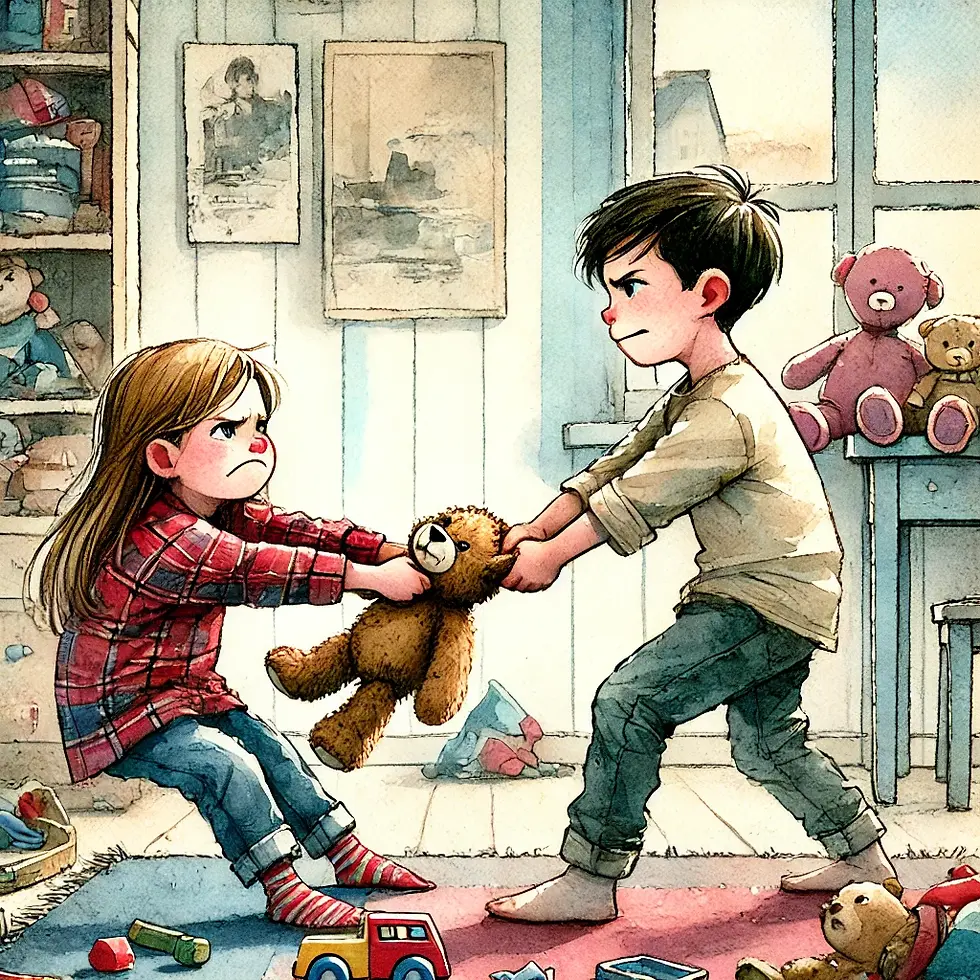Handling Manipulative Behaviors and Sibling Conflicts: A Comprehensive Approach
- Parita Sharma
- Jan 14
- 11 min read
Handling Manipulative Behaviors and Sibling Conflicts: A Comprehensive Approach

Addressing manipulation, tantrums, and sibling conflicts requires consistent parenting strategies, teaching life lessons, and setting boundaries. Here’s an integrated guide:
1. Managing Sibling Conflicts: The “Win-Win” Approach
Step 1: Take Away the Object of Conflict
When two children are fighting over something (e.g., a toy), take it away temporarily.
Say calmly: "Since you both are arguing over this, I’ll hold onto it until you can find a way to share it fairly."
Step 2: Encourage a “Win-Win” Solution
Ask: "How can you both use this in a way that feels fair to both of you?"
Guide them to brainstorm solutions (e.g., taking turns, setting a timer, or playing together).
If they reach an agreement, praise them: "Great job working together! Here’s the toy back."
Step 3: Teach the Lesson
Explain why cooperation matters: "When you solve problems together, it helps everyone feel happy and included. That’s what teamwork is about."
2. Teaching “Real Success” and “Real Failure”
What is Real Success?
Success is learning how to solve problems, cooperate, and manage emotions constructively.
Emphasize that success doesn’t mean always “winning” or “getting what you want” but finding a solution that works for everyone.
What is Real Failure?
Failure happens when behaviors like tantrums, manipulation, or fighting don’t lead to desired outcomes.
Explain that failure is not bad; it’s an opportunity to learn and try differently next time.
3. If Parents “Give In”
When parents give in to tantrums or manipulation for convenience or to avoid public embarrassment, it reinforces the behavior.
Message to the Child: “If I throw a tantrum or manipulate, I’ll eventually get what I want.”
Result: The behavior is likely to repeat.
4. If Parents Don’t Give In
When parents stay consistent and don’t give in, despite discomfort:
The child learns: "Tantrums don’t work; I need to find another way to get what I want."
Message to the Child: Behaviors that don’t yield success feel like a "failure," which teaches them to adjust.
Result: Over time, the behavior diminishes.
Example:
Child: (Screams and cries for candy in a store.)
Parent: (Calmly) "I see you’re upset, but I already said no. Crying won’t change my decision."
If the child escalates: "Since you’re upset, we’ll finish shopping quickly and leave. No candy today." (Exit the store and discuss expectations at home.)
Consistency shows the child tantrums won’t work.
5. Role-Playing Example: Teaching Life Lessons
Scenario 1: Sibling Conflict
Parent: "You’re fighting over the toy, so I’ll hold onto it for now. What can you do to share it fairly?"Child 1: "I want it first!"Child 2: "No, I want it first!"Parent: "Think of a way that works for both of you. Maybe you can take turns for five minutes each, or play together. Let me know when you’ve decided."
Outcome if they agree: "Great job finding a solution together. Here’s the toy back."
Outcome if they can’t agree: "Until you solve the problem, the toy will stay with me. I’m sure you’ll think of something soon."
Scenario 2: Handling Public Tantrum
Child: (Crying loudly) "I want that toy now!"Parent: "I know you want the toy, but we’re not buying toys today."Child: (Escalates the tantrum)Parent: "You have two choices: We can finish shopping calmly, or we’ll leave the store without any treats. What’s your choice?"
If the child calms down: "Thank you for calming down. That was a good choice."
If the child continues: "You’ve chosen to leave. Let’s go home and talk about it there."
Reflect Later:
Parent: "I know you were upset, but tantrums don’t work. If you really want something, let’s talk about how you can earn it."
6. Helping the Child Reflect on Behaviors
After conflicts or tantrums have calmed down, help the child understand the outcomes.
For Success: "You found a way to share the toy! That’s teamwork and success."
For Failure: "Throwing a tantrum didn’t get you what you wanted. Next time, how can you ask differently?"
By staying consistent, teaching problem-solving, and focusing on real-life lessons about success and failure, parents can guide children toward better behavior and emotional regulation.
Note to Parents: Empower, Don’t Overprotect
As parents, it’s natural to want to protect your child, think for them, and solve their problems. However, the real responsibility of a parent is not to do the thinking or problem-solving for their child, but to create an environment that encourages the child to think, explore, and solve problems on their own.
Children may not always arrive at the "correct" solutions right away, and that’s perfectly okay—experiencing failure and learning from mistakes is an essential part of psychological development. Each failure is an opportunity for your child to grow in resilience, adaptability, and emotional intelligence.
Why This Matters
Short-term ease vs. long-term growth: Solving every problem for your child may resolve temporary issues, but it stunts their ability to think critically, make decisions, and develop independence. Over time, this can disturb the parent-child relationship and lead to dependency or resentment.
Building a healthy relationship: Allowing your child to face challenges, while providing support and guidance, builds trust, mutual respect, and a healthier lifelong bond.
Children are in this world through parents, not for parents: Recognize that your role is to guide and nurture, not to control or dictate their path.
Yes, It Will Be Hard
Facilitating this growth will take a toll on you in the short term. Watching your child struggle or fail can be uncomfortable and even heartbreaking. However, this discomfort is a small price to pay for fostering a self-reliant, confident individual who can navigate life successfully and maintain a healthy relationship with you.
By stepping back and letting your child experience challenges, you teach them:
That they are capable of solving problems.
That failure is not an end but a stepping stone to success.
That you trust their abilities, which builds their confidence and self-esteem.
Choose the path of fostering lifelong growth over temporary solutions—it’s an investment in your child’s future and your relationship with them.

સંચાલનાત્મક વલણો અને ભાઈ-બહેનો વચ્ચેના સંઘર્ષો હલ કરવા માટેનો વ્યાપક દ્રષ્ટિકોણ
સંચાલન, તનાવ અને ભાઈ-બહેનો વચ્ચેના ઝગડાઓને હલ કરવા માટે સતત પેરેન્ટિંગની રણનિતિઓ, જીવનના પાટિયા શીખવવામાં અને મર્યાદાઓ સુયોજિત કરવાની જરૂર છે. અહીં એક સંકલિત માર્ગદર્શિકા છે:
1. ભાઈ-બહેનોના સંઘર્ષો સંભાળવી: "વિન-વિન" દ્રષ્ટિ
સટ્પ 1: વિવાદિત વસ્તુ દૂર કરી નાખો
જ્યારે બે બાળકો કોઈ વસ્તુ (ઉદાહરણ તરીકે, રમકડું) માટે લડતા હોય છે, ત્યારે તે તાત્કાલિક રીતે દૂર કરી લો.
શાંતિપૂર્વક કહો: "તમારા બંને વચ્ચે આ બાબતે ઝઘડો ચાલી રહ્યો છે, તેથી હું આ રમકડું ત્યાં સુધી રાખું છું જ્યાં સુધી તમે બંને આ ન્યાયસંગત રીતે વહેંચવાનો ઉપાય શોધી શકતા નથી."
સટ્પ 2: "વિન-વિન" ઉકેલ પ્રોત્સાહિત કરો
પૂછો: "તમારા બંને માટે આ ન્યાયસંગત રીતે કેવી રીતે વહેંચી શકાય છે?"
તેમને ઉપાય શોધવા માટે માર્ગદર્શન આપો (જેમ કે, વળાંક લેવું, ટાઈમર સેટ કરવું અથવા સાથે રમવું).
જો તેઓ કરાર પર પહોંચે, તો તેમની પ્રશંસા કરો: "સાથે કામ કરવા માટે શાનદાર કામ કર્યું! અહીં તમારું રમકડું પાછું છે."
સટ્પ 3: પાઠ શીખવો
સમજૂતી કેમ મહત્વપૂર્ણ છે તે સમજાવો: "જ્યારે તમે સાથે કામ કરીને સમસ્યાઓ ઉકેલો છો, ત્યારે તે બધા માટે ખુશી અને સમાવેશિત થવા માટે મદદરૂપ થાય છે. તે જ ટીમ વર્ક છે."
2. "વાસ્તવિક સફળતા" અને "વાસ્તવિક નિષ્ફળતા" શીખવવી
વાસ્તવિક સફળતા શું છે?
સફળતા એટલે સમસ્યાઓ ઉકેલવી, સહકાર આપવો અને નિર્માણાત્મક રીતે ભાવનાઓનું સંચાલન કરવું.
એમફસાઇઝ કરો કે સફળતા હંમેશા "જીતવા" અથવા "તમને શું જોઈએ છે તે મેળવવા" વિશે નથી પરંતુ દરેક માટે કામ કરે છે તેવા ઉકેલ શોધવા વિશે છે.
વાસ્તવિક નિષ્ફળતા શું છે?
જ્યારે કૃત્યો જેમ કે તનાવ, સંચાલન અથવા ઝઘડાઓ અપેક્ષિત પરિણામો તરફ દોરી જતા નથી ત્યારે નિષ્ફળતા થાય છે.
સમજાવો કે નિષ્ફળતા ખરાબ નથી; તે શીખવાની અને બીજી વખત અલગ રીતે પ્રયાસ કરવાની તક છે.
3. જો માતાપિતા "સોટા પડે"
જ્યારે માતાપિતા તાત્કાલિક અડચણ દૂર કરવા અથવા જાહેર શરમિયાઈને ટાળી લેવામાં ટાળામટોળ કરે છે, ત્યારે તે આ કૃત્યને મજબૂત બનાવે છે.
બાળકને સંદેશ: "જો હું તનાવ અથવા સંચાલન કરું, તો મને અંતે જે જોઈએ છે તે મળશે."
પરિણામ: આ વ્યવહાર પુનરાવર્તિત થવાની શક્યતા છે.
4. જો માતાપિતા "સોટા ન પડે"
જ્યારે માતાપિતા સ્થિર રહે છે અને સોટા ન પડે, ત્યારે બાળક શીખે છે:
"તનાવ કામ નહીં કરે; મને જે જોઈએ છે તે મેળવવા માટે બીજો માર્ગ શોધવાની જરૂર છે."
બાળકને સંદેશ: "સોંગની પરિણામ છે તે વિજ્ઞાન શીખે છે."
પરિણામ: સમય જતાં આ કૃત્ય ઘટે છે.
ઉદાહરણ:
બાળક: (દુકાનમાં મીઠાઈ માટે ચીજવટકરે છે).
માતા/પિતા: (શાંતિપૂર્વક) "મને ખબર છે કે તને મીઠાઈ જોઈતી છે, પણ મેં પહેલાથી જ ના પાડી છે. રડવાથી મારું નિર્ણય બદલાશે નહીં."
જો બાળક વધારે કદર કરે: "તને ભૂખ લાગે છે."
ગાઈડલાઇન સરળ રહે.
માતાપિતાઓ માટે નોંધ: સશક્ત કરો, વધુ રક્ષણશીલ ન બનો
માતાપિતા તરીકે, તમારા બાળકને સુરક્ષિત રાખવા, તેમના માટે વિચારવા અને તેમની સમસ્યાઓ હલ કરવા ઈચ્છવું સ્વાભાવિક છે. પરંતુ માતાપિતાનું સાચું જવાબદારી એ નથી કે બાળક માટે વિચારે અથવા તેમની સમસ્યાઓ હલ કરે, પરંતુ એક એવું પર્યાવરણ બનાવવું જ્યાં બાળક પોતે વિચારી શકે, શોધી શકે અને પોતાનાં પ્રશ્નોનું સમાધાન કરી શકે.
બાળકો હંમેશા "સાચા" ઉકેલ પર નહીં પહોંચે, અને તે સંપૂર્ણપણે ઠીક છે—અસફળતા અનુભવો અને ભૂલોથી શીખવું માનસિક વિકાસનો એક મહત્વપૂર્ણ ભાગ છે. દરેક નિષ્ફળતા તમારા બાળકને લવચીકતા, અનુકૂળતા અને ભાવનાત્મક બુદ્ધિમાં વૃદ્ધિ કરવા માટે એક તક આપે છે.
આ કેમ મહત્વનું છે?
આંતરિક અને દીર્ઘગાળાનો વિકાસ: તમારા બાળકની દરેક સમસ્યાનો ઉકેલ શોધવો કદાચ તત્કાલ અડચણોને દૂર કરે છે, પરંતુ તે તેમની ચિંતનશીલતા, નિર્ણાયકતાના કુશળતા અને સ્વતંત્રતા વિકાસમાં અવરોધ બની શકે છે. લાંબા ગાળે, આ માતા-પિતાના સંબંધોને હાનિ પહોંચાડી શકે છે અને નિર્ભરતા અથવા આકરોસ પેદા કરી શકે છે.
સ્વસ્થ સંબંધ બાંધવું: તમારા બાળકને પડકારોનો સામનો કરવા દેવું, જ્યારે સમર્થન અને માર્ગદર્શન પૂરું પાડવું, વિશ્વાસ, પરસ્પર સન્માન અને એક સારી જીવનભર સુમેળભર્યો સંબંધ બાંધે છે.
બાળકો માતાપિતાઓ દ્વારા આ દુનિયામાં છે, માટે નહીં: તમારા ભુમિકા માર્ગદર્શન આપવા અને લાલન કરવાની છે, નિયંત્રણ અથવા તેમના માર્ગને નક્કી કરવાની નથી.
હા, તે મુશ્કેલ થશે
આ વિકાસને સુગમ કરવું તમારા માટે ટૂંકા ગાળામાં મુશ્કેલ બનશે. તમારા બાળકને સંઘર્ષ કરતો અથવા નિષ્ફળ થતો જોવું અસુવિધાજનક અથવા હૃદયદ્રાવક હોઈ શકે છે. પરંતુ આ અસુવિધા એક સ્વતંત્ર, આત્મવિશ્વાસયુક્ત વ્યક્તિ બનાવવાની અને તેમના જીવનને સફળતાપૂર્વક સંચાલિત કરવાની આ સશક્ત પ્રક્રિયામાં નાણાં મૂકી શકવાની નાની કિંમત છે.
તમારા બાળકને પડકારોનો સામનો કરવાની તક આપીને, તમે તેમને શીખવશો:
કે તેઓ સમસ્યાઓ હલ કરવામાં સક્ષમ છે.
કે નિષ્ફળતા અંત નથી, પરંતુ સફળતાના રસ્તામાં એક પગથિયું છે.
કે તમે તેમના પર વિશ્વાસ રાખો છો, જે તેમની આત્મવિશ્વાસ અને આત્મસન્માનની ભાવનાને મજબૂત બનાવે છે.
તાત્કાલિક ઉકેલો કરતા જીવનભર વિકાસને પ્રોત્સાહન આપવાનો માર્ગ પસંદ કરો—તે તમારા બાળકના ભવિષ્ય અને તમારા બંને વચ્ચેના સંબંધ માટે એક મહત્વપૂર્ણ રોકાણ છે.

व्यवस्थित व्यवहार और भाई-बहनों के बीच संघर्ष को संभालने के लिए व्यापक दृष्टिकोण
बच्चों के मनमाने व्यवहार, गुस्से और भाई-बहनों के बीच झगड़ों को सुलझाने के लिए स्थिर पालन-पोषण रणनीतियों, जीवन के पाठ और सीमाओं को निर्धारित करने की आवश्यकता होती है। यहां एक विस्तृत मार्गदर्शिका दी गई है:
1. भाई-बहनों के झगड़े को संभालना: "विन-विन" दृष्टिकोण
चरण 1: विवादित वस्तु हटा दें
जब दो बच्चे किसी चीज़ (जैसे खिलौना) के लिए झगड़ रहे हों, तो उस वस्तु को अस्थायी रूप से हटा दें।
शांति से कहें: "क्योंकि आप दोनों इस पर झगड़ रहे हैं, मैं इसे तब तक रखूंगा जब तक आप इसे न्यायसंगत तरीके से साझा करने का तरीका नहीं निकाल लेते।"
चरण 2: "विन-विन" समाधान प्रोत्साहित करें
पूछें: "आप दोनों इसे ऐसे कैसे उपयोग कर सकते हैं जो आप दोनों के लिए उचित हो?"
उन्हें समाधान सोचने में मार्गदर्शन करें (जैसे, बारी-बारी से खेलना, टाइमर सेट करना या साथ में खेलना)।
यदि वे सहमत होते हैं, तो उनकी सराहना करें: "साथ मिलकर समाधान ढूंढने के लिए अच्छा काम किया! यह रहा आपका खिलौना।"
चरण 3: पाठ सिखाएं
यह समझाएं कि सहयोग क्यों महत्वपूर्ण है: "जब आप समस्याओं को मिलकर सुलझाते हैं, तो यह सभी को खुश और शामिल महसूस करने में मदद करता है। यही टीमवर्क है।"
2. "वास्तविक सफलता" और "वास्तविक असफलता" सिखाएं
वास्तविक सफलता क्या है?
सफलता का मतलब है समस्याओं को हल करना, सहयोग करना और भावनाओं को रचनात्मक तरीके से प्रबंधित करना।
समझाएं कि सफलता का मतलब हमेशा "जीतना" या "जो चाहिए उसे पाना" नहीं है, बल्कि ऐसा समाधान खोजना है जो सभी के लिए काम करे।
वास्तविक असफलता क्या है?
असफलता तब होती है जब व्यवहार, जैसे गुस्सा, जिद या झगड़े, अपेक्षित परिणाम नहीं देते।
समझाएं कि असफलता बुरी नहीं है; यह सीखने और अगली बार अलग तरीके से प्रयास करने का एक अवसर है।
3. जब माता-पिता "झुक जाते हैं"
यदि माता-पिता झगड़े या सार्वजनिक शर्मिंदगी से बचने के लिए तुरंत बच्चे की मांग पूरी कर देते हैं, तो यह व्यवहार को और मजबूत करता है।
बच्चे के लिए संदेश: "यदि मैं जिद करूंगा या गुस्सा करूंगा, तो मुझे आखिरकार वह मिल जाएगा जो मैं चाहता हूं।"
परिणाम: यह व्यवहार दोहराया जाएगा।
4. जब माता-पिता "झुकते नहीं"
जब माता-पिता स्थिर रहते हैं और झुकते नहीं, तब:
बच्चा सीखता है: "जिद काम नहीं करती; मुझे अपना उद्देश्य प्राप्त करने के लिए दूसरा तरीका अपनाना होगा।"
बच्चे के लिए संदेश: असफलता को स्वीकार करना और सुधार करना सीखना।
परिणाम: समय के साथ यह व्यवहार कम हो जाता है।
उदाहरण:
बच्चा: (दुकान में जोर से चिल्लाते हुए) "मुझे अभी वह खिलौना चाहिए!"
माता-पिता: (शांति से) "मुझे पता है कि तुम खिलौना चाहते हो, लेकिन आज हम खिलौने नहीं खरीद रहे हैं।"
यदि बच्चा और जिद करता है: "मैं समझता हूं कि तुम नाराज़ हो, लेकिन चिल्लाने से मेरा निर्णय नहीं बदलेगा।"
यदि बच्चा शांत हो जाता है: "धन्यवाद कि तुमने समझदारी से निर्णय लिया। यह तुम्हारे लिए सही था।"
5. रोल-प्ले उदाहरण: जीवन का पाठ सिखाना
परिदृश्य 1: भाई-बहनों के बीच झगड़ा
माता-पिता: "आप दोनों खिलौने के लिए झगड़ रहे हैं, इसलिए मैं इसे अभी अपने पास रख रहा हूं। क्या आप इसे साझा करने का कोई तरीका सोच सकते हैं?"बच्चा 1: "मैं पहले खेलूंगा!"बच्चा 2: "नहीं, मैं पहले खेलूंगा!"माता-पिता: "कोई ऐसा तरीका सोचो जो आप दोनों के लिए काम करे। शायद आप बारी-बारी से खेल सकते हैं या साथ में खेल सकते हैं। जब आप तय कर लेंगे तो मुझे बताएं।"
यदि वे सहमत होते हैं: "अच्छा काम! यह रहा आपका खिलौना।"
यदि वे सहमत नहीं होते हैं: "जब तक आप समाधान नहीं सोचते, खिलौना मेरे पास रहेगा। मुझे यकीन है कि आप जल्द ही कुछ सोचेंगे।"
परिदृश्य 2: सार्वजनिक गुस्सा
बच्चा: (जोर से रोते हुए) "मुझे अभी वह खिलौना चाहिए!"माता-पिता: "मुझे पता है कि तुम खिलौना चाहते हो, लेकिन आज हम खिलौने नहीं खरीद रहे हैं।"बच्चा: (जिद करते हुए रोना जारी रखता है)माता-पिता: "तुम्हारे पास दो विकल्प हैं: या तो हम शांति से खरीदारी पूरी करें, या फिर बिना किसी चीज़ के घर चले जाएं। क्या तुमने फैसला कर लिया?"
यदि बच्चा शांत हो जाता है: "धन्यवाद, कि तुमने शांत रहकर सही निर्णय लिया।"
यदि बच्चा और जिद करता है: "तुमने दुकान छोड़ने का विकल्प चुना। चलो अब घर चलते हैं।"
6. बच्चे को व्यवहार पर चिंतन करना सिखाएं
जब विवाद या गुस्से की स्थिति शांत हो जाए, तो बच्चे को उनके व्यवहार के परिणाम समझाएं।
सफलता के लिए: "तुमने खिलौने को साझा करने का तरीका निकाला! यह टीमवर्क और सफलता है।"
असफलता के लिए: "जिद करने से तुम्हें वह नहीं मिला जो तुम चाहते थे। अगली बार इसे अलग तरीके से कैसे करोगे?"
इस दृष्टिकोण को अपनाकर, माता-पिता बच्चों को समस्या-समाधान और आत्म-नियंत्रण के बेहतर तरीके सिखा सकते हैं, और उनके दीर्घकालिक विकास को बढ़ावा दे सकते हैं।
माता-पिता के लिए नोट: सशक्त करें, अत्यधिक संरक्षक न बनें
माता-पिता के रूप में, अपने बच्चे की रक्षा करना, उनके लिए सोचना और उनकी समस्याओं को हल करना स्वाभाविक है। लेकिन माता-पिता की असली जिम्मेदारी यह नहीं है कि वे बच्चे के लिए सोचें या उनकी समस्याओं को हल करें, बल्कि ऐसा वातावरण तैयार करना है जो बच्चे को स्वयं सोचने, खोजने और अपनी समस्याओं का समाधान करने के लिए प्रेरित करे।
बच्चे हमेशा "सही" समाधान तक नहीं पहुंच सकते, और यह पूरी तरह से ठीक है—असफलता का अनुभव करना और गलतियों से सीखना मनोवैज्ञानिक विकास का एक महत्वपूर्ण हिस्सा है। हर असफलता आपके बच्चे को लचीलापन, अनुकूलनशीलता और भावनात्मक बुद्धिमत्ता में विकसित होने का अवसर देती है।
यह क्यों महत्वपूर्ण है?
क्षणिक सुविधा बनाम दीर्घकालिक विकास: आपके बच्चे की हर समस्या का समाधान ढूंढना शायद तात्कालिक समस्याओं को हल कर सकता है, लेकिन यह उनकी सोचने की क्षमता, निर्णय लेने की कुशलता और आत्मनिर्भरता के विकास को रोकता है। समय के साथ, यह माता-पिता और बच्चे के संबंधों में निर्भरता या कड़वाहट पैदा कर सकता है।
स्वस्थ संबंध बनाना: अपने बच्चे को चुनौतियों का सामना करने देना, जबकि आप समर्थन और मार्गदर्शन प्रदान करें, विश्वास, पारस्परिक सम्मान और एक मजबूत आजीवन संबंध बनाता है।
बच्चे इस दुनिया में माता-पिता के माध्यम से आए हैं, माता-पिता के लिए नहीं: यह समझें कि आपकी भूमिका उन्हें मार्गदर्शन और पोषण देने की है, न कि उनका रास्ता नियंत्रित करने या तय करने की।
हां, यह कठिन होगा
इस विकास प्रक्रिया को आसान बनाना आपके लिए अल्पकालिक रूप से मुश्किल हो सकता है। अपने बच्चे को संघर्ष करते या असफल होते देखना असुविधाजनक या दुखदायी हो सकता है। लेकिन यह असुविधा आपके बच्चे को आत्मनिर्भर, आत्मविश्वासी और जीवन में सफलतापूर्वक आगे बढ़ने वाले व्यक्ति के रूप में विकसित करने की कीमत है।
अपने बच्चे को चुनौतियों का सामना करने का मौका देकर, आप उन्हें सिखाते हैं:
कि वे समस्याओं को हल करने में सक्षम हैं।
कि असफलता अंत नहीं है, बल्कि सफलता की ओर एक कदम है।
कि आप उनके कौशल और क्षमताओं पर भरोसा करते हैं, जो उनके आत्मविश्वास और आत्म-सम्मान को मजबूत करता है।
क्षणिक समाधानों के बजाय दीर्घकालिक विकास को प्राथमिकता देने का रास्ता चुनें—यह आपके बच्चे के भविष्य और आपके साथ उनके रिश्ते में एक अमूल्य निवेश है।





Comments